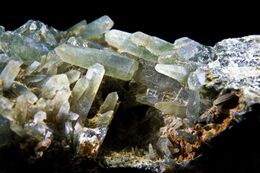Chemistry:Prasiolite
| Prasiolite | |
|---|---|
 | |
| General | |
| Category | Oxide mineral |
| Crystal system | Trigonal |
| Identification | |
| Color | Shades of green |
| Crystal habit | Hexagonal prisms |
| Cleavage | None |
| Fracture | Conchoidal[1] |
| Tenacity | Brittle[1] |
| Mohs scale hardness | 7 – lower in impure varieties[1] |
| Diaphaneity | Transparent to nearly opaque |
| Specific gravity | 2.65 |
| Refractive index | 1.544 to 1.553[2] |
| Birefringence | 0.009[3] |
| Ultraviolet fluorescence | None |
Prasiolite (also known as green quartz, green amethyst or vermarine) is a green variety of quartz.
Since 1950, almost all natural prasiolite has come from a small Brazil ian mine, but it has also been mined in the Lower Silesia region of Poland . Naturally occurring prasiolite has also been found in the Thunder Bay area of Canada .[4]
Most prasiolite sold is used in jewellery settings, where it can substitute for far more expensive precious gemstones.
Prasiolite is a rare stone in nature; artificial prasiolite is produced by heat treatment of amethyst.[4] Most amethyst will turn yellow or orange when heated, producing heat-treated amethysts which are often marketed as citrine, but some amethyst will turn green when treated. Currently, almost all prasiolite on the market results from a combination of heat treatment and ionizing radiation.[5]
Green quartz is sometimes incorrectly called green amethyst,[6] which is not an acceptable name for the material according to Federal Trade Commission Guidelines. Other names for green quartz include vermarine and lime citrine.[7]
The word prasiolite literally means "scallion green-colored stone" and is derived from Greek πράσον prason meaning "leek" and λίθος lithos meaning "stone". The mineral was given its name due to its green-colored appearance.
Natural prasiolite is a very light, translucent green. Darker green quartz is generally the result of artificial treatment.[8]
See also
References
- ↑ 1.0 1.1 1.2 "Prasiolite gemstone information". http://www.gemdat.org/gem-40112.html.
- ↑ Lazarelli. Blue Chart Gem Identification. p. 7. http://www.gembluechart.com.
- ↑ "PRASIOLITE the green variety of quartz (aka Green Amethyst)". http://www.galleries.com/Prasiolite.
- ↑ 4.0 4.1 "Prasiolite". quarzpage.de. 28 October 2009. http://www.quartzpage.de/prasiolite.html.
- ↑ "Mineral Spectroscopy Server". California Institute of Technology. 11 June 2012. http://minerals.gps.caltech.edu/index.html.
- ↑ "Green Amethyst". GemSelect. http://www.gemselect.com/other-info/green-amethyst.php.
- ↑ "Green Quartz Meaning and Properties". n.d.. https://www.firemountaingems.com/resources/encyclobeadia/gem-notes/l55b.
- ↑ Gems and Gemstones: Timeless Natural Beauty of the Mineral World By Lance Grande, Allison Augustyn, p.91
External links
 |

